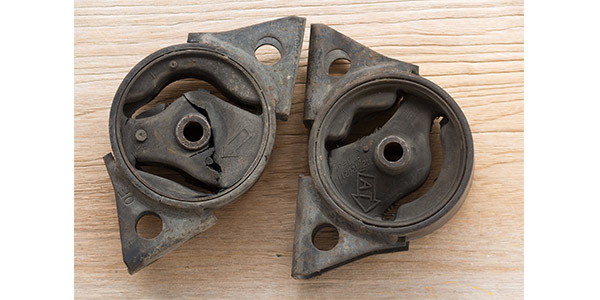
Motor mounts fail for a variety of reasons. The first cause is mechanical fatigue. Every combustion cycle and firing, a little vibration is created. The vibration is transferred to the motor mount. Every time the driver hits the gas, the force generated at the crankshaft is transferred through the drivetrain and ends up at the tires. Making sure these components stay in place and transfer all the power are the engine and transmission mounts. These actions can cause rubber and metal to fatigue.
The other cause of mount failure is environmental. Most mounts live deep in the engine bay where they are exposed to high temperatures and leaking fluids from the engine. The rubber is also exposed to higher-than-normal levels of ozone, which is the natural enemy of rubber.
The other cause of motor mount failure is the control system. Many mounts can control the stiffness of the mount. This can be done with engine vacuum or with electric valves and electronics. If the mount is “dead,” vibration can occur and engine movement can’t be controlled.
Diagnostics
A customer’s complaints are just as significant as the test drive. It is easy to hear a failed mount that is allowing the engine to swing back and forth. But, conditions where a weak mount causes the exhaust system to come in contact with the underbody under certain throttle conditions, can be difficult to replicate. This is where the customer complaint can help.
If a mount fails, it can cause problems that might appear to be unrelated to the mount. Movement of the engine can put stress on the EVAP lines that go from the firewall to the intake manifold. Electrical connectors and battery cables can be stretched to the point that you could have a no start condition. Vacuum-powered mounts can leak causing idle problems and possibly lean fuel trims on some vehicles. Also, if a vehicle has a leaking exhaust flex pipe or ball and flange connector, inspect the engine and transmission mounts.
If the mount is variable, you might have to look at the pulse-width modulated signal with a scope to see if the ECM is changing the valving. On older mounts, use of a vacuum gauge, and maybe a smoke machine, can help to spot leaks.
Another tool to help isolate vibrations is an accessory for some scopes. This tool creates an interface between an accelerometer and three channels of a scope. The accelerometer is connected to the base of the driver’s seat. Software and an OBDII connector can display the three axes of vibration and engine RPM on a computer. This can take the “human butt” element out of the diagnosis.
Inspection
It is a good idea to test the engine mounts in the bay. With an assistant in the driver’s seat, have them apply the brakes and gently push the throttle while you stand at the side of the engine bay. Some movement of the engine or transmission is acceptable. But large movements that stretch and pull hoses and cables are not good.
Look at the mounts. If the rubber is cracked or separated from the metal components, they need to be replaced. If the mount is covered in any fluid, make sure the leak is resolved before the new mount is installed.
Late-model hydraulic motor mounts are not filled with oil. They are filled with a glycol-based fluid tuned to the engine and chassis structure. When an engine or transmission mount ruptures, you might not see the leak because the liquid can be quickly washed away by rainwater.













